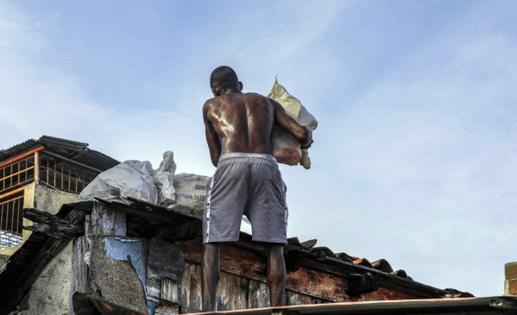Hurricane Melissa threatens several Caribbean islands, challenging disaster responders
Published in News & Features
Hurricane Melissa’s rapid intensification and its projected torrential rain are highlighting the problems for emergency responders who will have to deal with crises on several Caribbean islands simultaneously in coming days, according to the Caribbean’s top disaster management expert.
After striking Jamaica, where it’s expected to make landfall as a powerful Category 5 hurricane, Melissa is forecast to also hit Cuba, the southern Bahamas and the low-lying Turks and Caicos Islands. Haiti and parts of the Dominican Republic, which have already experiencing flooding, could also see life-threatening flash floods and landslides from the slow-moving system.
In response to the pending disaster from Melissa’s devastating winds, rains and storm surges, the Caribbean Disaster Emergency Management Agency and the United Nations said Monday they are readying to respond.
The storm is posing “a new level of complexity for emergency managers,” said Elizabeth Riley, executive director of the Barbados-based Caribbean Disaster Emergency Management Agency.
Riley said two key elements stand out about the slow-moving storm: Its rapid intensification and extreme rainfall potential. The system rapidly progressed from a tropical storm to Category 4 in less than 24 hours.
“What is fueling this are the incredibly warm waters in our region, and this is essentially the energy for the hurricanes and warmer waters, higher sea level temperatures. This is a direct result of climate change,” she said. “The second thing is around the precipitation.”
Riley also described the National Hurricane Center’s projected rainfall accumulations as “unprecedented.”
“The impact of 30 to 40 inches of rainfall from an incredibly slow-moving system is a deep concern,” she said.
The Caribbean region, she said, is seeing high levels of precipitation not only with tropical cyclones like Melissa, but other severe weather events.
Storms targets Jamaica, Haiti, Cuba
With Melissa expected to bear down on Jamaica on Monday and Tuesday, disaster responders are also keeping a close eye on Haiti, the Dominican Republic, the Cayman Islands, the southern Bahamas and the Turks and Caicos Islands. On Wednesday the storm is forecast to cross the southeastern Bahamas, where dangerous storm surges can also wreak devastation.
“We saw these types of interactions during Hurricane Dorian in The Bahamas, where we had very significant storm surges of around 20 feet or higher, along with precipitation of around 25 inches or so,” Riley said. “And what happens in these scenarios is that the sea is coming inland, and you have at the same time run off in very high levels coming from the land.”
On Monday, hurricane conditions began affecting Jamaica while tropical storm conditions were also felt in Haiti. The potential for hurricane conditions in Haiti decreased, but the country, which is vulnerable to floods and landslides, was not in the clear.
There is a significant threat of catastrophic flash flooding, landslides and urban flooding in Haiti and Jamaica, and further risk of flash flooding in the southeast Bahamas.
Delano Seiveright, a member of Jamaica’s Parliament for St. Andrew North Central said while the capital of Kingston and much of the eastern section of the island may be spared the most destructive effects, the situation remains grave.
“A Category 4 or 5 system is catastrophic under any circumstance, and despite the extensive national preparations and many well-constructed buildings, no one can ever be truly ready for a storm at that intensity. Should the storm maintain its strength and trajectory, some communities, particularly in western Jamaica, could face damage reminiscent of Gilbert or worse,” he said, referring to the 1988 storm that left 49 dead and destroyed more than 100,000 homes.
Seiveright’s constituency of St. Andrew North Central covers the north-central section of the Kingston metropolitan area. It includes a mix of affluent and middle-class neighborhoods and densely populated inner-city communities, some of which straddle the huge Sandy Gully, the city’s main drainage canal.
“These areas are particularly vulnerable, and we’ve been working nonstop with authorities and residents to prepare,” he said. “Utility companies, emergency services, and community teams have been fully engaged, and the public has taken this storm seriously. Still, we must brace for the reality that some communities will be badly affected and that recovery will take time.”
A U.S. State Department spokesperson told the Miami Herald that the agency continues “to closely monitor” the hurricane, but that a decision to deploy assistance “will not be made until a need is identified.”
Farhan Haq, deputy spokesperson for United Nations Secretary-General António Guterres, said Monday that U.N. regional humanitarian offices are coordinating with country teams and the Caribbean Disaster Emergency Management Agency and emergency authorities. The U.N. Office for the Coordination of Humanitarian Affairs is also deploying staff to Cuba and Jamaica this week, as conditions allow.
The U.N. World Food Program is providing logistics support, including generators, while the United Nations Children’s Fund, UNICEF, has pre-positioned water and sanitation supplies. The Pan-American Health Organization is reinforcing health emergency operations, while the International Organization for Migration is preparing shelter support. The U.N. Development Program, the Food and Agriculture Organization and the U.N. Population Fund are mobilizing for early recovery and protection.
The agencies “are prepositioning relief supplies, including medical and nutrition supplies, as well as supporting with cash assistance, early-warning messaging and community outreach,” Haq said.
In Cuba, where the hurricane is anticipated to hit Wednesday morning, the Anticipatory Action Framework has been activated with a $4 million allocation released from the U.N. Central Emergency Response Fund ahead of the storm.
“This allowed our partners to preposition food and essential supplies – including rice, grains, hygiene kits, fuel vouchers and portable water-treatment plants – in the eastern provinces,” Haq said.
A reminder of hurricanes Maria, Harvey
Josh Dozor, a former deputy assistant administrator of the Federal Emergency Management Agency, said Melissa’s path reminds him of Hurricane Maria, which devastated Puerto Rico, Dominica and other islands in the northeastern Caribbean in September 2017.
“I see a lot of similarities,” said Dozor, the current general manager of medical and security assistance at International SOS, which has clients throughout the areas in the storm’s path. “We’re going to see prolonged flooding over a long time.”
Tim McShane, lead security analyst for North America and Caribbean for the company, said he is concerned about clients who have been calling and are sheltering in place. Melissa reminds him of another slow-moving storm, Hurricane Harvey.
Melissa, he said, is “a very large and powerful storm, but it’s also creeping extremely, extremely slow, only a couple miles per hour,” said McShane who is from Houston, where Harvey struck in August 2017. “So what’s going to happen is that as the storm approaches Jamaica it is just going to continue dumping rain across the island.”
Jamaica will need help after storm
Seiverighs said while Jamaicans “are a resilient people,” the country of 2.8 million “will undoubtedly need significant international aid and support to rebuild in the aftermath, particularly if the storm’s projected path holds and delivers the kind of damage forecasters are warning about.
“We’ve weathered storms and crises before, and we’ve always found the strength to rebuild, stronger and more united,” he said. “Our collective vigilance, patience, and unity will once again be key in the days ahead.”
_____
©2025 Miami Herald. Visit miamiherald.com. Distributed by Tribune Content Agency, LLC.







Comments